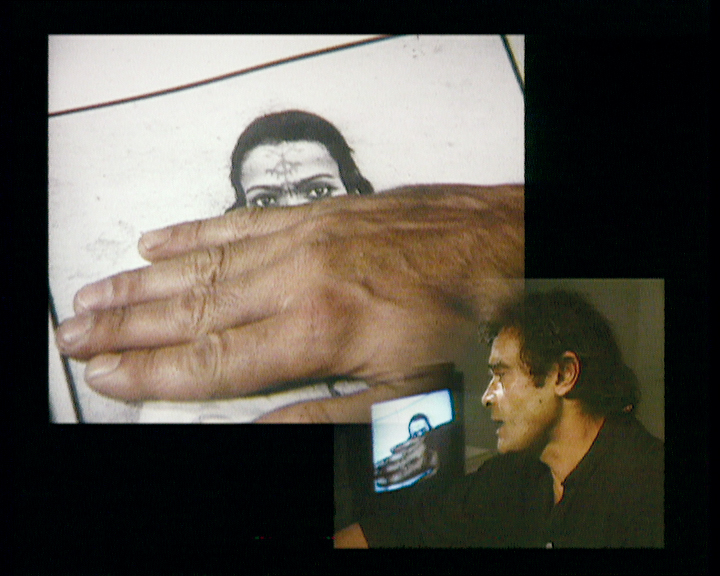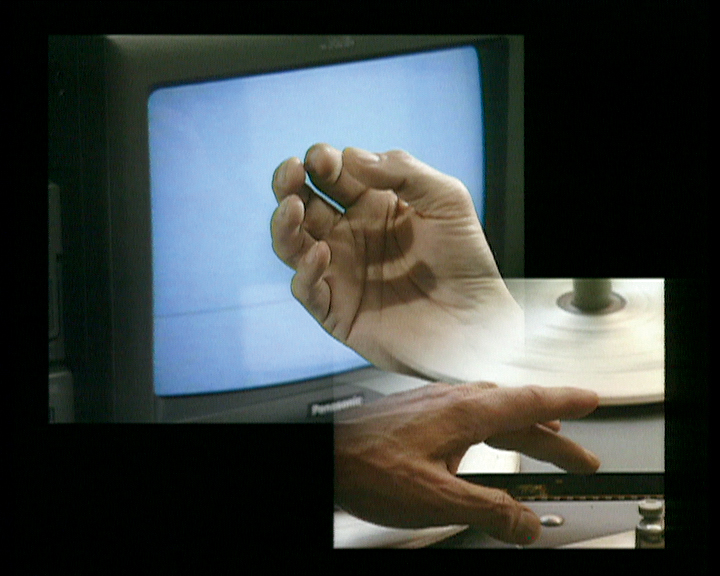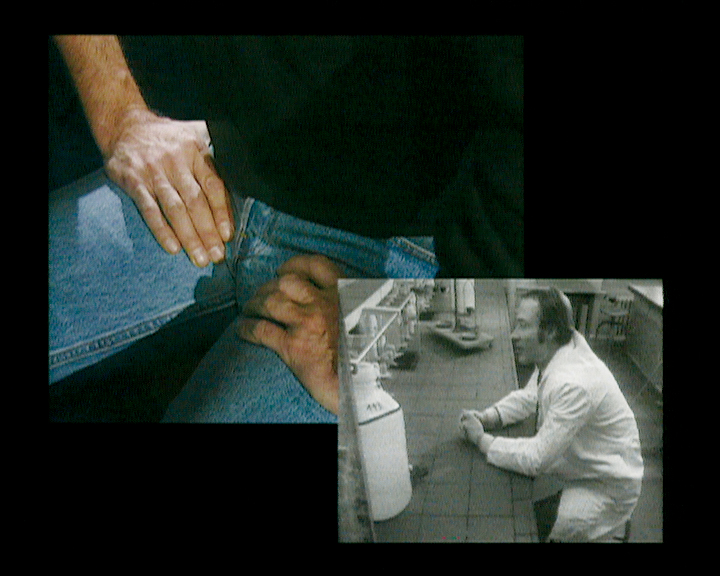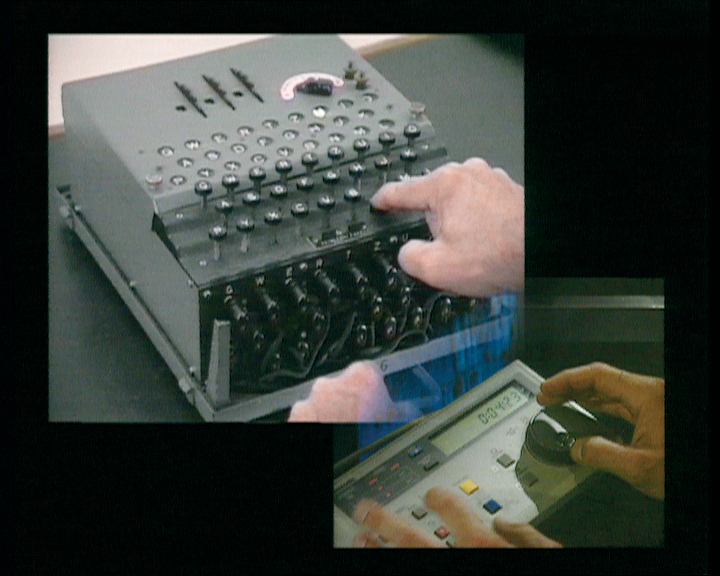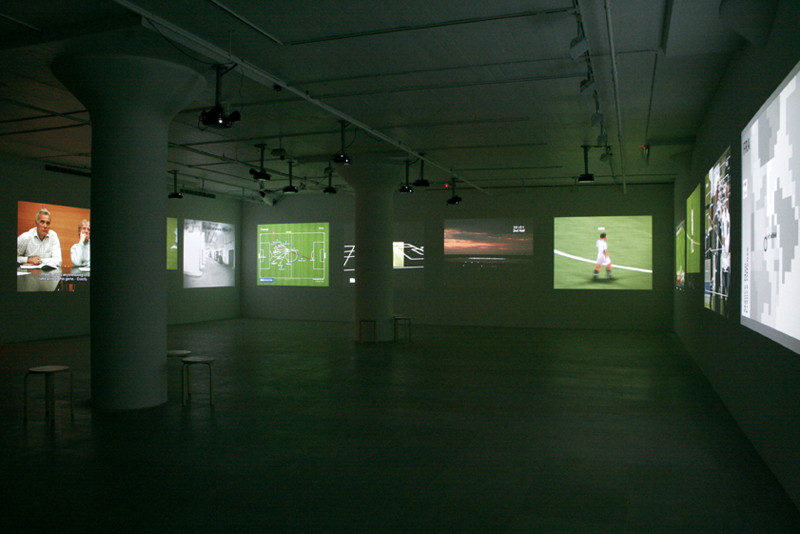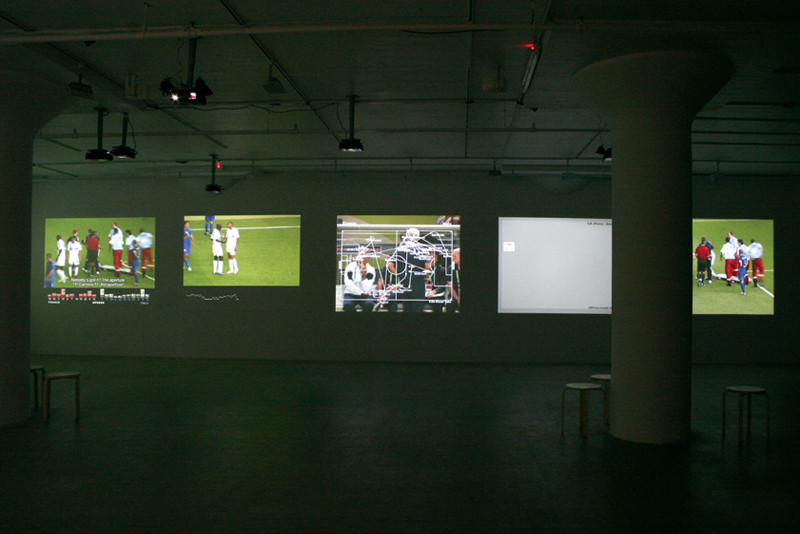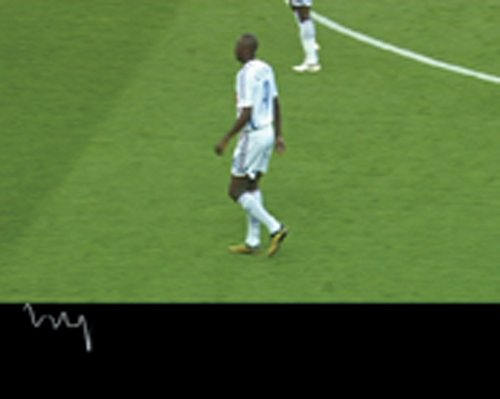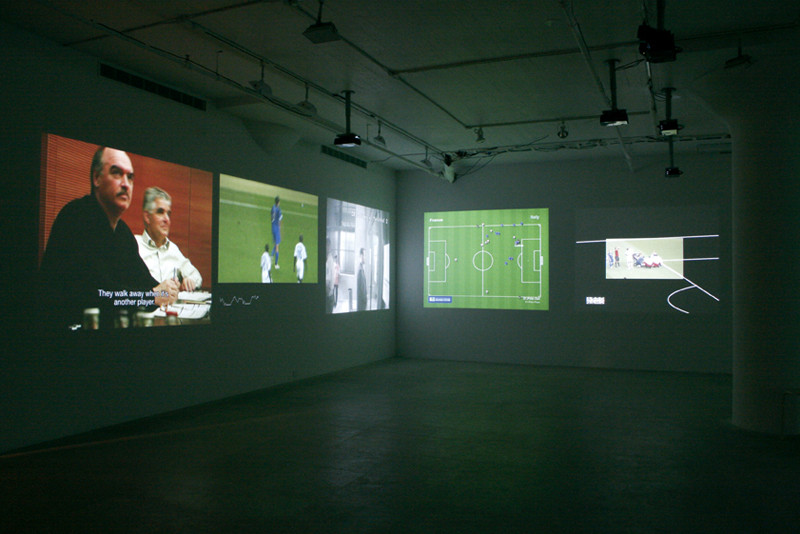[Spring 2008]
The video installation Deep Play, discussed here, will be presented at the DHC/ART Foundation for Contemporary Art in Montreal from February 21 to May 25, 2008.The video installation Deep Play, discussed here, will be presented at the DHC/ART Foundation for Contemporary Art in Montreal from February 21 to May 25, 2008. Deep Play consists of a real-time documentation of the final 2006 World Cup of Soccer match between France and Italy. Harun Farocki harvested visual artefacts produced during the game using different image-analysis and -capture devices. On the visual image that television viewers of the event would see are superimposed and juxtaposed schematic images that enable different cultural institutions and industries to rationalize and control the exploitation of such an event: digital sequences that analyze the players’ movements, statistics adding up the different actions on the playing field, images from surveillance cameras, and so on.
by André Habib and Pavel Pavlov
Pavel Pavlov : Your films expose various institutions: prisons, the military, advertising, or, as in the installation Deep Play, the worlds of television and soccer. What is the nature of your exchanges with these institutions?
Harun Farocki : I can’t really say it’s an exchange. An institution such as FIFA is very bureaucratic; it holds a monopoly and doesn’t have to try to be likable. It was different for the companies and research centres that developed information- or image-processing software, because they were trying to promote or sell them. I know a woman who wrote a dissertation on the possibility of transforming an image into text. For her, soccer is a good example to take, because, all in all, there are few rules. Starting from the moment when you have a player moving on the field, it is possible to define his action: he has passed the ball, he has scored a goal, and so on. It is quite simple to fix his coordinates. This woman was not interested in soccer in itself, but only in the fact that it’s a good example of a reduced system. I’m interested in soccer somewhat for the same reasons. At the same time, there are few events that attract as many cameras. So much human intelligence focused on a few hundred square metres of grass! In the end, these industries do the same thing with soccer as they do with factories and battlefields.
PP : Did you install cameras yourself during the shooting?
HF : Only one, on the balcony, for general shots. All the other images in the installation are “quotations.”
PP : Deep Play exposes the role of different industries in the organization and exploitation of this kind of media event. How did you conceive of this installation, which was a centrepiece at Documenta?
HF : First of all, the idea came from the curator, Roger Buergel. He commissioned the work and found the funds necessary to finance it. He didn’t warn me that it would be presented in the rotunda [of the Museum Fridericianum]; I didn’t know that until much later. At the beginning, we wanted to project it on screens, but in the end we opted for flat screens because there was no space and little light.
Recently, in Oslo, the work was exhibited according to my original wish, on 12 projection screens [Oslo Museum of Contemporary Art, October 13, 2007–January 6, 2008]. I believe it’s better this way, because there’s no question of hierarchy. You can’t have the cross references between the images when all the screens are compressed into a tight space. If you pull back, you should see the twelve images, but at Documenta, it was possible to see only three or four.
PP : Let’s return to your relationship with institutions. How do the people who represent them see your work?
HF : Thirty years ago, people believed that television would be very influential. So they dressed well, they tried to say profound things, they asked me to film this machine rather than that one because it was newer, and so on. Now, the atmosphere is more relaxed. They have learned in the meantime that these details won’t have any impact, and they leave you to film. Before, I might give a story: “I work for television, and we are making a series (very normal) on factories.” Today, they check out the Web right away and they get to know, more or less, who I am and what I’ve done. In 2000, when I began a project on weapons and the military industry, there was very little interest in war, so it was easier to get material. Then, September 11 happened and it became very difficult to access certain archives in the United States. But at the same time, the military industry has become concerned with its image, and it is trying to promote its technology, so it is once again possible to access certain things. In general, there is much less bureaucracy than there was thirty years ago, which makes things easier. For example, it is quite amazing to realize that people who work in the military industry are extremely intelligent. You can have very serious discussions with them on strategic and ethical issues. They aren’t “war heads.” They know what they’re doing. It’s quite surprising. So, there was one guy who was very happy to leave his job because he got work as a teacher. And one public-relations manager who was thrilled to see that someone had made something connected to the work they were doing from an aesthetic viewpoint, and not a traditional report. These are pretty strange encounters…
André Habib : A number of filmmakers (Akerman, Kiarostami, Varda) seem to have found a sense of freedom in museums that they are deprived of today in the film world. Since some of your works exist as both film and installation, do you have to think of both forms when you start a project?
HF : If we take the example of Œil/Machine, it’s practical to be able to produce a few installations in parallel with film productions. It’s like when you write a book, and you publish articles using the same research material. In general, on the other hand, I try, even when I am having a show in a museum, to be a documentary maker and not a visual artist.
AH : A number of your films, even before you begin to produce the installations, seem to have a “potential for installation.” You often try to think of images as simultaneous, not as a chain of images that disappear. For example, your film Images du monde et inscription de la guerre could be shown on multiple screens or channels. Would you say that the spatialization of your work in the gallery space is already present in your films?
HF : Yes, you’re right. When I saw Chantal Akerman’s D’est, I understood how it was possible to isolate certain elements of a film and make an installation with them. This has to do with a certain way of constructing things. One could also say that the loop, as a characteristic, has always been present in my work. Even in one of my first films, Feu inextinguible, there is this loop structure, where things come back. I think I was influenced by Brecht, but on this particular point by Beckett, who was very influential at the time.
PP : A number of your films draw on Marxist thought, while others evoke semiotics. Today, do you have a theoretical model that you work with?
HF : In 1968, when I was working on Feu inextinguible, I had read mainly Marx, and very little of Christian Metz or Umberto Eco. That came later. Similarly, it wasn’t until much later that we discovered Benveniste in Germany, the history of semiotics, theories of the sign. Of course, I was influenced by Foucault, and also by Virilio. Even though I don’t share some of their ideas, they are very inspirational. What Virilio said about missiles, during the Gulf War, was very true. But I can’t say that I have a theoretical model. I think that people who work in the media have a tendency to exaggerate, and to think that everything is media. I don’t share this opinion. I think that material production is important, even if it tends to become more and more immaterial. I also think that contradictions between ideological superstructures and modes of production are not really considered today.
AH : At the same time, it seems that you don’t lack collaborators today. A few years ago you started a project, a lexicon of movie expressions, with Friedrich Kittler and Wolfgang Ernst; you co-wrote a book with Kaja Silverman on Godard [Speaking about Godard]. Although Godard seems to be in an increasingly solitary, isolated position, you don’t seem to be undergoing the same solitude.
HF : No, in fact. I have friends, collaborators. I’ve set up a reading circle, like when I was twenty years old. In the last two years we’ve read Agamben and Rancière, as a group. The members are young professors, people who work in the cultural world. In addition, my position as a teacher in Vienna enables me to meet very interesting people. I don’t feel like I lack conversation. At the same time, I tell myself that we don’t know anything about the real world. We should hold salons where it would be possible to meet chemists and physicists, but that doesn’t seem to have happened. Fortunately, thanks to my documentaries, I am led to explore certain areas, which allows me to learn a bit more about computers, the war industry, designers of commercial galleries. This is part of the societal reality. I often go on research trips with large companies. I visit more companies than museums. It’s a chance…
AH : You should take Godard with you. That way…
HF : That’s a great idea. Maybe he’d feel less alone!
This interview took place during the exhibition of Harun Farocki One Image Doesn’t Take The Place Of The Previous One at Concordia University’s Leonard & Bina Ellen Gallery in Montreal.
The complete version of this interview can be seen on the Web site of Hors champ (www.horschamp.qc.ca)
André Habib is currently completing a Doctoral thesis in literature at the University of Montreal on the imagination of ruins in cinema. He has taught at the four Montreal universities and is the co-author of a book on Chris Marker that will be published by L’Harmattan in 2008.
Pavel Pavlov is an artist. He is preparing a Doctoral thesis on exterior conceptual photography in the 1960s and 70s.


